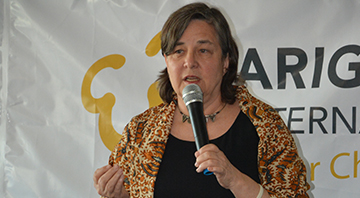
The Balkan nations and especially Sarajevo share a lush beauty and visible presence of history. Warm hospitality and the bustling hordes of tourists suggest that peace and prosperity are at least around the corner. The graceful spires of Ottoman minarets, Orthodox churches, Cathedrals, and synagogues, one upon another, are vivid testimony to a history and present where different religious communities are integrally part of the society. But Sarajevo’s peaceful surface masks a history of intractable conflicts and a present with many raw tensions and knotty poverty challenges, high unemployment and intergroup tensions among them.
 Meeting in Sarajevo obliged the Interim Steering Committee to wrestle with contradictions that forced us to look behind and beyond any bland approach to child poverty. What are the root causes of child suffering? What do children’s rights mean in this context? Why, notwithstanding bold international and national peacebuilding efforts and courageous leaders working there for decades, do the problems persist? Why must young people, born after the years of war, still live with the scars of conflict? And what can be done to change the narrative, to look to a future driven by hope?
Meeting in Sarajevo obliged the Interim Steering Committee to wrestle with contradictions that forced us to look behind and beyond any bland approach to child poverty. What are the root causes of child suffering? What do children’s rights mean in this context? Why, notwithstanding bold international and national peacebuilding efforts and courageous leaders working there for decades, do the problems persist? Why must young people, born after the years of war, still live with the scars of conflict? And what can be done to change the narrative, to look to a future driven by hope?
We learned constantly during our days in Sarajevo, challenged to press for answers both to the bold questions of what can ensure that no child is left behind, and what WE together might do differently. Answers are elusive but I emerged from Sarajevo with a deeper appreciation for six related challenges, determined to seek a deeper understanding of their importance and new ideas for action.
- Resolving conflicts and building peace so that children can grow up with hope deserves our highest priority. We know that development in any form is impossible without peace; conflict destroys physical and social achievements. But peace is not possible without development, because development is about hope and a better future. Without that beacon young people can fall into negativity and despair. And development starts with quality education.
- Children should never be seen as helpless victims. We were reminded by an articulate group of young people who acted out a scenario of bullying, discrimination, and conflict resolution, that they have insight, voice, strength, and determination. Listening to them is a vital step towards action.
- Focusing on children means focusing on mothers. Fathers are of course important but gender inequalities are inextricably linked to core issues of child poverty, for girls and boys. Women need to be actively and directly involved and we should never shy away from gender issues nor allow them to be marginalized.
- We know that a society can best be judged by how it treats its weakest members, including for example orphans, child brides, and victims of domestic violence. This is a call to focus on vulnerable children and to look for them even in prosperous settings where their presence may be close to invisible.
- Religious communities are often the guardians of culture, and we know how difficult it can be to disentangle what ideas and actions come truly from faith and which come closer to culture. Religious actors can help in celebrating the positive aspects of culture. But they can also help to identify and change those aspects of cultures that hold communities back, for example ideas linked to women’s inequality or tolerant of domestic violence. We need to shine a spotlight on practices that damage and harm children. Ancient wisdom goes alongside modern gifts such as technology and new understandings of universal rights and child welfare.
- Inequalities between rich and poor and among communities are most visible and most unacceptable where children are involved. Dealing with the issues of inequity is a central call to action.
We are brought together, as a movement and as a Steering Committee, by the goal of ending child poverty, determined to work to make it a leading global priority. That is also a personal mission for each of us. To move ahead, individually and collectively, we need to believe that indeed it is possible to end poverty. We can take inspiration from the societies where child poverty is an ancient memory, evoked by history and stories like the fairy tale of Hansel and Gretel but something left behind. We look up to faith communities, with their special gifts and responsibilities, to goad and lead action, at global and local levels. And to help show the way to new insights, fresh examples of success, and clearer visions of the challenges we need to face.